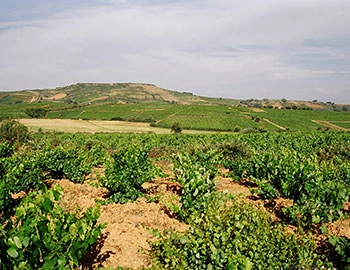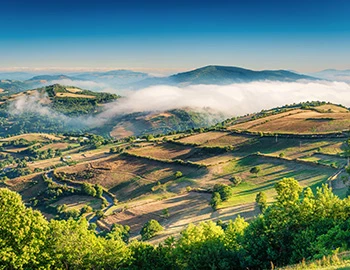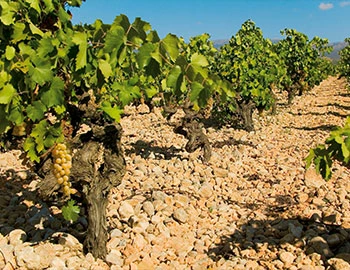El Valtuille La Cova de la Raposa 2020
DO Bierzo, Castro Ventosa, 750 ml

| Grape variety: | Mencia |
| Producer: | Castro Ventosa / Fam. Pérez Pereira |
| Origin: | Spain / Galicia / Bierzo |
Description
Intense fruity aromas of raspberry, blueberry and dark cherry on the nose. Reveals after a little aeration in the glass, notes of violets and exotic spices. Filling on the palate, with powerful but elegant tannins, the Cova de la Raposa ends in a long and fine finish.
Attributes
| Origin: | Spain / Galicia / Bierzo |
| Grape variety: | Mencia |
| Label: | Vegan |
| Ripening potential: | 3 to 15 years |
| Drinking temperature: | 16 to 18 °C |
| Food Pairing: | Goulash, boeuf bourguignon, Roast saddle of venison, Wild specialities |
| Vinification: | pressing the whole grape, fermentation in wooden barrel |
| Harvest: | hand-picking, strict selection |
| Maturation: | in new barriques |
| Maturation duration: | 12 months |
| Volume: | 13.5 % |
| Note: | Contains sulphites |
Castro Ventosa / Fam. Pérez Pereira
Castro Ventosa - a bodega in the heart of the Bierzo vineyards. The DO Bierzo, in northwestern Spain, covers about 3500 hectares of vineyards, 70 % of which are between 40 to over 100 years old. On limestone soils interspersed with sand, the indigenous grape variety Mencía feels particularly at home here
In 1752, a member of the Pérez Pereira family acquired 54 hectares of land in Valtuille de Abajo. Today, the family has been growing wine here for four generations. The most famous winemaker in the region is probably Alvaro Palacios, although his family winery Palacios Remondo is in Rioja. Alvaro came to the region as a flying winemaker for the Castro Ventosa winery, where he learned how to work with Mencía before founding his own bodega, thus making the Bierzo region known throughout the world.Thanks not least to the know-how of Alvaro Palacios and the ambition and experience of the Pérez Pereira family, the two wines El Valtuille and El Castro del Valtuille are now among the best wines made from the Mencía grape.

Castro Ventosa / Fam. Pérez Pereira
Castro Ventosa - a bodega in the heart of the Bierzo vineyards. The DO Bierzo, in northwestern Spain, covers about 3500 hectares of vineyards, 70 % of which are between 40 to over 100 years old. On limestone soils interspersed with sand, the indigenous grape variety Mencía feels particularly at home here
In 1752, a member of the Pérez Pereira family acquired 54 hectares of land in Valtuille de Abajo. Today, the family has been growing wine here for four generations. The most famous winemaker in the region is probably Alvaro Palacios, although his family winery Palacios Remondo is in Rioja. Alvaro came to the region as a flying winemaker for the Castro Ventosa winery, where he learned how to work with Mencía before founding his own bodega, thus making the Bierzo region known throughout the world.Thanks not least to the know-how of Alvaro Palacios and the ambition and experience of the Pérez Pereira family, the two wines El Valtuille and El Castro del Valtuille are now among the best wines made from the Mencía grape.

Bierzo
Bierzo: to the top with the Mencia variety
At the beginning of the 90s, the Bierzo region, which is crossed by the Camino de Santiago, was barely known in the international wine scene. It was only when new residents and investors began to bottles top crus from selected slopes, which perfectly united finesse and force, that interest in this region and its primary variety grew. This variety, Mencia, is considered one of the highest quality red wine varieties in the Iberian Peninsula.

Galicia
Galicia: shaped by the cool Atlantic
Situated in the far northwest of the Iberian Peninsula, Galicia is like a tip which pushes west toward the Atlantic Ocean, north of Portugal. In keeping with this exposed location, wines made here, with their fresh, straightforward character, depart strikingly from the general style of Spanish wines. With four cultivation areas with DO status, Galicia is drawing noticeably more international interest. White wines from autochthonous varieties are mostly produced here.

Spain
Spain – Variety and perfection
“Somewhere in la Mancha, in a place whose name I do not care to remember...,” begins Don Quixote's odyssey.
The most famous part is definitely when Don Quixote thinks windmills are his enemy and wants to fight them – until they nearly kill him. It’s possible there was a bit too much of the La Mancha wine at play. Spanish vines fight for their survival in rugged landscapes, battling fierce drought and rough soils. But they fight well.



